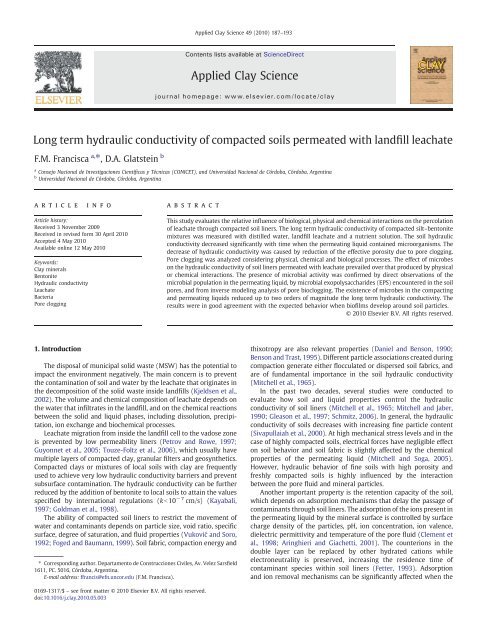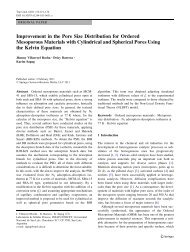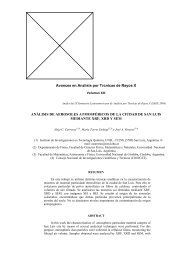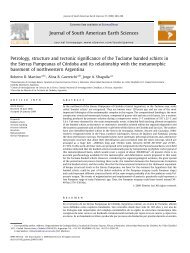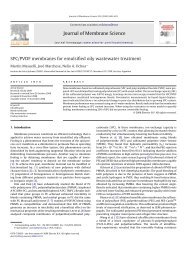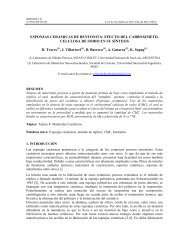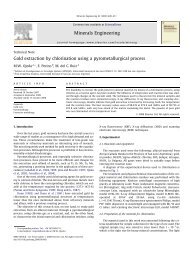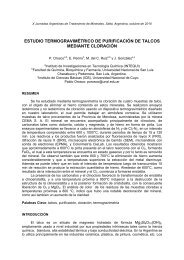Long term hydraulic conductivity of compacted soils permeated with ...
Long term hydraulic conductivity of compacted soils permeated with ...
Long term hydraulic conductivity of compacted soils permeated with ...
Create successful ePaper yourself
Turn your PDF publications into a flip-book with our unique Google optimized e-Paper software.
188 F.M. Francisca, D.A. Glatstein / Applied Clay Science 49 (2010) 187–193permeating liquid contains several ions as in the case <strong>of</strong> polyelectrolytesand landfill leachate (Kietlińska and Renman, 2005).The purpose <strong>of</strong> this study is to evaluate the simultaneous effect <strong>of</strong>clay content, soil porosity, chemical precipitation and microbiologicalproperties <strong>of</strong> the permeating liquid on the long <strong>term</strong> <strong>hydraulic</strong><strong>conductivity</strong> <strong>of</strong> <strong>compacted</strong> silt and silt–bentonite mixtures.2. Materials and methods2.1. Soil samplesThe <strong>soils</strong> were silt and bentonite. Table 1 summarizes relevantphysical properties <strong>of</strong> these materials as well as Scanning ElectronMicroscopy (SEM) images and Energy Dispersive X-ray (EDX)analyses.The silt was a typical soil from the Chaco–Pampean plain, formedby very fine sand, silt and clay particles lifted by wind and transportedby eolian action (Iriondo, 1997; Zarate, 2003). These quaternarysediments cover more than 600,000 km 2 <strong>of</strong> the center and north-east<strong>of</strong> Argentina and are frequently used as construction materials forliners. However, the mean <strong>hydraulic</strong> <strong>conductivity</strong> <strong>of</strong> this soil aftercompaction is in the 10 − 6 cm/s range and insufficient to be used inlandfill liners (Nieva and Francisca, 2009). For this reason, bentoniteor other clay minerals capable <strong>of</strong> lowering the <strong>hydraulic</strong> <strong>conductivity</strong>are commonly added to these silts to achieve the values required forthe construction <strong>of</strong> containment barriers.The bentonite contained more than 92% <strong>of</strong> sodium montmorillonite(data provided by Minarmco SA). This type <strong>of</strong> soil is frequentlyused in landfill liners, slurry walls and many other geoenvironmentalapplications due to its expansive characteristic and low <strong>hydraulic</strong><strong>conductivity</strong> (Gleason et al., 1997).2.2. Compaction and permeating liquidsThe compaction and permeating liquids were: a) distilled water(DW), b) nutrient solution (NS), and c) landfill leachate (LL). Thenutrient solution contained 2% glucose, 0.1% NaCl, 0.1% yeast, 0.05%MgSO 4 , 0.08% K 2 HPO 4 , 0.02% KH 2 PO 4 and 7.5×10 −4 % FeCl 3 (Dennisand Turner, 1998). The main properties <strong>of</strong> the landfill leachate aresummarized in Table 2. Before testing, the leachate was filtered <strong>with</strong> aqualitative P5 filter paper to remove solid particles <strong>with</strong> diametersN5–10 µm. Yeast and naturally growing bacteria in the nutrientssolution and indigenous bacteria in the leachate controlled thebiological activity in these two permeating liquids.2.3. Sample preparation and <strong>hydraulic</strong> <strong>conductivity</strong> testsSoil specimens were dried at 105 °C during 24 h. The silt fractionwas then mixed <strong>with</strong> different amounts <strong>of</strong> bentonite (Table 3). Theoptimum moisture content for the different soil mixtures ranged from17.6% to 19.6% and the compaction liquid content was 20% in all cases.In this case, a dispersed microstructure is expected for all specimenssince they were <strong>compacted</strong> in the right side <strong>of</strong> the compaction curve(Daniel and Benson, 1990). Finally, the wet <strong>soils</strong> were <strong>compacted</strong> inrigid-wall compaction–mold permeameters using the standardproctor energy (ASTM D698 — ASTM, 2007).Hydraulic <strong>conductivity</strong> tests were performed by the falling headtechnique following the ASTM D5856 standard procedure (ASTM,2007), <strong>with</strong> <strong>hydraulic</strong> gradients between 6.5 and 2.1. The permeatingliquid <strong>of</strong> each tested sample is indicated in Table 3.The <strong>hydraulic</strong> <strong>conductivity</strong> was measured every week during15 months by monitoring the volume <strong>of</strong> liquid <strong>permeated</strong> throughthe specimens.Table 1Relevant properties <strong>of</strong> tested <strong>soils</strong>.Soil SEM images EDX microanalysis PropertiesSiltLiquid limit=27%Plastic index=2.8%Particles b74 µm =96%Particles b2 µm=4%Specific gravity=2.67Specific surface=2.5 m 2 /gBentoniteLiquid limit=285%Plastic index=240%Particles b74 µm =100%Particles b2 µm=80%Specific gravity=2.71Specific surface=731 m 2 /g
F.M. Francisca, D.A. Glatstein / Applied Clay Science 49 (2010) 187–193189Table 2Minimum and maximum values <strong>of</strong> chemical parameters <strong>of</strong> the leachate used as permeating liquid.Parameter Range Parameter Range Parameter RangeBOD (mg/l) 2500–68,500 Total dissolved solids (mg/l) 13,120–51,100 Magnesium (mg/l) 59–3860COD (mg/l) 17,400–93,700 Alkalinity (mg CaCO 3 /l) 3730–23,150 Iron (mg/l) 28–126TKN (mg/l) 784–2576 pH 5.2–8.1 Manganese (mg/l) 15–96Organic N (mg/l) 24–852 Total hardness (mg CaCO 3 /l) 520–23,100 Chromium (mg/l) 0.14–2.20Ammonia-N (mg/l) 61–2250 Chloride (mg/l) 582–4700 Lead (mg/l) 0.11–12.00Nitrate (mg/l) 80–550 Sulfate (mg/l) 80–2000 Cadmium (mg/l) 0.11–0.62Total P (mg/l) 5.20–23.50 Sodium (mg/l) 645–29,200 Zinc (mg/l) 1.0–13.5Phenols (mg/l) 3.45–26 Potassium (mg/l) 70–2786 Nickel (mg/l) 0.03–2.1Conductivity (µS) 21,136–68,742 Calcium (mg/l) 42–2880 Copper (mg/l) 0.20–6.602.4. Modeling and data analysisThe <strong>hydraulic</strong> conductivities measured in all samples wereanalyzed by considering the main fluid and soil properties featuredby the Kozeny–Carman equation (Mitchell and Soga, 2005):k = ρgμ1K n T 2 S 2 0!e 3S 31+ewhere k is the <strong>hydraulic</strong> <strong>conductivity</strong>, g the acceleration <strong>of</strong> gravity, ρthe fluid mass density, μ the viscosity, T the tortuosity, K n the poreshape factor, S 0 the wetted surface area per unit volume <strong>of</strong> particles, ethe void ratio and S the degree <strong>of</strong> saturation.The evolution <strong>of</strong> the <strong>hydraulic</strong> <strong>conductivity</strong> <strong>with</strong> time <strong>of</strong>permeation was analyzed by considering two possible mechanisms:a) carbonate precipitation (VanGulck et al., 2003) and b) biocloggingmechanisms (MacLeod et al., 1988; Vandevivere, 1995). The amount<strong>of</strong> carbonates in the soil specimen was de<strong>term</strong>ined by the CO 2production <strong>with</strong> hydrochloric acid (ASTM D4373, 2007). Thebiological activity was confirmed by microbiological tests <strong>of</strong> thepermeating liquids collected in the inlet and outlet ports. Thesemeasurements were performed by the Heterotrophic Plate Count(HPC) technique, following the American Standard Methods for theExamination <strong>of</strong> Water and Wastewater, using the pour plate method<strong>with</strong> Plate Count Agar and inoculating at 35 °C during 24 h (APHA,1995). Bacteria detected in the NS and LL at 5 and 15 months <strong>of</strong>permeation were in the range <strong>of</strong> 10 5 CFU/mL and 10 3 CFU/mL,respectively.Table 3Tested samples.Soil fractions (%)Silt BentoniteCompactionfluidPermeatingliquidDry density(g/cm 3 )e 3 kr01+e 0100 0 DW DW 1.61 0.161 0.8195 5 DW DW 1.57 0.192 1.1890 10 DW DW 1.55 0.206 1.71100 0 NS NS 1.56 0.200 0.0295 5 NS NS 1.52 0.233 0.0690 10 NS NS 1.50 0.254 0.09100 0 DW LL 1.60 0.173 0.0695 5 DW LL 1.53 0.223 0.0290 10 DW LL 1.53 0.226 0.01100 0 NS LL 1.53 0.224 0.0295 5 NS LL 1.54 0.218 0.0290 10 NS LL 1.49 0.260 0.03100 0 DW LL 1.57 0.191 0.0395 5 DW LL 1.55 0.206 0.1090 10 DW LL 1.51 0.241 0.04Note: DW=distilled water, NS=nutrient solution, LL=landfill leachate, e 0 =initialvoid ratio, kr =<strong>hydraulic</strong> <strong>conductivity</strong> ratio.ð1ÞHydraulic <strong>conductivity</strong> changes related to either carbonateprecipitation or bioclogging were analyzed by considering theinfluence <strong>of</strong> expected reductions <strong>of</strong> void ratio according to thetheoretical Kozeny–Carman model (Eq. (1)), as follows:kr = k f= 1+e e 30 fð2Þk 0 1+e f e 0where kr is the <strong>hydraulic</strong> <strong>conductivity</strong> ratio and the subscripts ‘0’ and‘f’ represent initial and final states, respectively. Note that e f includesthe effect <strong>of</strong> chemical precipitation and/or bioclogging and that Eq. (2)assumes negligible changes in liquid properties, tortuosity andspecific surface during the tests. However, particles completelysurrounded by bi<strong>of</strong>ilms may be considered as equivalent largerparticles <strong>with</strong> lower specific surface (Santamarina et al., 2001). Theexpected change <strong>of</strong> specific surface area is generally smaller than oneorder <strong>of</strong> magnitude when 95% <strong>of</strong> pores are filled <strong>with</strong> biomass and canbe computed as (Clement et al., 1996):Mr = M f= e 2 != 2f 3 1+e =03ð3ÞM 0 e 0 1+e fwhere Mr is the specific surface area ratio, and M f and M 0 the final andinitial specific surface area respectively. In addition, this effect can be<strong>of</strong> relevance in the case <strong>of</strong> coarse sediments <strong>with</strong> large pores sizes buthas little influence in the case <strong>of</strong> fine <strong>soils</strong> <strong>with</strong> very small pore sizes.3. ResultsThe <strong>hydraulic</strong> <strong>conductivity</strong> <strong>of</strong> <strong>compacted</strong> silt–bentonite mixturesshowed negligible time dependence when the testing liquid was DWand decreased significantly <strong>with</strong> the bentonite content (Fig. 1a). Morethan 5% <strong>of</strong> bentonite was needed to achieve kb10 − 7 cm/s, as requiredby current regulations. Conversely, the samples <strong>compacted</strong> and<strong>permeated</strong> <strong>with</strong> nutrient solutions exhibited notable reductions <strong>of</strong> k<strong>with</strong> permeation time (Fig. 1b).Similar trends were observed when the specimens were <strong>compacted</strong><strong>with</strong> DW and NS, and <strong>permeated</strong> <strong>with</strong> LL (Fig. 2). Specimens<strong>compacted</strong> <strong>with</strong> DW exhibited a time dependent behavior when<strong>permeated</strong> <strong>with</strong> leachate (Fig. 2a) in contrast to the observed trendwhen <strong>permeated</strong> <strong>with</strong> DW (Fig. 1a). In addition, k decreased almostone order <strong>of</strong> magnitude after 12 months <strong>of</strong> testing, and the observeddecrease was faster when the specimens were <strong>compacted</strong> <strong>with</strong> NSthan when <strong>compacted</strong> <strong>with</strong> DW.All samples <strong>compacted</strong> <strong>with</strong> DW showed higher <strong>hydraulic</strong><strong>conductivity</strong> than those <strong>compacted</strong> <strong>with</strong> NS after 12 months <strong>of</strong>testing, regardless <strong>of</strong> bentonite content. However, in both cases kclearly decreased <strong>with</strong> increasing bentonite content (Figs. 1a and 2a),and also showed some variability <strong>with</strong> permeation time for samples<strong>compacted</strong> <strong>with</strong> NS (Figs. 1b and 2b).
190 F.M. Francisca, D.A. Glatstein / Applied Clay Science 49 (2010) 187–193Fig. 1. Influence <strong>of</strong> time on the <strong>hydraulic</strong> <strong>conductivity</strong> <strong>of</strong> silt–bentonite mixtures:a) samples <strong>compacted</strong> and <strong>permeated</strong> <strong>with</strong> distilled water; b) samples <strong>compacted</strong> and<strong>permeated</strong> <strong>with</strong> nutrient solution. Numbers between brackets indicate the pore volume<strong>of</strong> flow after 15 months <strong>of</strong> permeation.Fig. 2. Influence <strong>of</strong> time on the <strong>hydraulic</strong> <strong>conductivity</strong> <strong>of</strong> silt–bentonite mixtures<strong>permeated</strong> <strong>with</strong> leachate: a) samples <strong>compacted</strong> <strong>with</strong> distilled water; b) samples<strong>compacted</strong> <strong>with</strong> nutrient solution. Numbers between brackets indicate the pore volume<strong>of</strong> flow after 15 months <strong>of</strong> permeation.The initial porosity (n 0 ) <strong>of</strong> <strong>compacted</strong> silt–bentonite mixtures hadnegligible influence on kr obtained after 15 months <strong>of</strong> testing (Fig. 3).In addition, there was a very small influence <strong>of</strong> bentonite content onkr when the specimens were <strong>compacted</strong> <strong>with</strong> the nutrients solution or<strong>permeated</strong> <strong>with</strong> this solution or leachate. kr became close to one whenthe permeating liquid was DW, given that k 0 ≅k f (Fig. 1a), and fellbetween 10 − 2 and 10 − 1 for the specimens <strong>permeated</strong> <strong>with</strong> LL. Theseresults confirmed the importance <strong>of</strong> liquid properties on the expectedfinal <strong>hydraulic</strong> <strong>conductivity</strong> <strong>of</strong> <strong>compacted</strong> earthen liners.Optical microscopy images confirmed the presence <strong>of</strong> bacteria andyeast in the liquid collected in the outlet port <strong>of</strong> all the samples tested<strong>with</strong> LL and NS (Fig. 4a). In addition, Fig. 4b shows microbialexopolysaccharides (EPS) detected in SEM images <strong>of</strong> the soil afterpermeation confirming the presence <strong>of</strong> microbial activity <strong>with</strong>in soilpores.Observed permeability changes could be related to: a) expansion/shrinkage <strong>of</strong> expansive minerals, b) mineral clogging, and c)bioactivity. The replacement <strong>of</strong> the Na + ions <strong>of</strong> the sodium bentoniteby more highly charged cations and/or the increase <strong>of</strong> ionicconcentration usually decrease the double-layer thickness, and risethe soil <strong>hydraulic</strong> <strong>conductivity</strong> (Schmitz, 2006). The landfill leachate,characterized by a high ionic concentration, should then increase the4. Discussion4.1. Soil propertiesIn this study all the specimens were <strong>compacted</strong> <strong>with</strong> moisturecontent higher than the optimum and consequently disperse fabricswere expected. In this condition, the measured <strong>hydraulic</strong> <strong>conductivity</strong>reached its lowest possible value, assuming no changes <strong>of</strong> compactionenergy and method (Mitchell and Soga, 2005).The initial void ratios ranged from 0.66 to 0.81 and could not beresponsible <strong>of</strong> any significant change <strong>of</strong> the <strong>hydraulic</strong> <strong>conductivity</strong>,k∝e 3 /(1+e), as theoretically shown by the Kozeny–Carman equation.In addition, the initial soil saturation (S) between 65% and 70%increased to N85% during the test. k decreased <strong>with</strong> the permeationtime even there were more pores participating in the flow due to thehigher saturation.Fig. 3. Relationship between the <strong>hydraulic</strong> <strong>conductivity</strong> ratio after 15 months <strong>of</strong>permeation and the initial soil porosity (n). Permeating liquids: DW=distilled water,NS=nutrient solution, LL=landfill leachate.
F.M. Francisca, D.A. Glatstein / Applied Clay Science 49 (2010) 187–193191due to bioactivity can be related to the presence <strong>of</strong> bi<strong>of</strong>ilms andassociated bioclogging mechanisms controlled by the relative size <strong>of</strong>microorganisms respect to pore and throat sizes.There are several theoretical and empirical models that can beused to estimate the influence <strong>of</strong> microorganisms on the decrease <strong>of</strong> k(Fig. 5). These models consider different mechanisms affecting<strong>hydraulic</strong> <strong>conductivity</strong>, which are associated <strong>with</strong> the presence <strong>of</strong>uniform bi<strong>of</strong>ilm accumulation (Vandevivere, 1995; Seki and Miyazaki,2001; Thullner et al., 2002), cell aggregate clogging mechanisms (Ivesand Pienvichitr, 1965; Clement et al., 1996) and the development <strong>of</strong>colonies (Thullner et al., 2002). The contribution <strong>of</strong> bacteria inreducing the <strong>hydraulic</strong> <strong>conductivity</strong> depends on the final void ratio(e f ) which is computed from kr, the initial void ratio (e 0 ) and Eq. (2).Furthermore, the volume <strong>of</strong> bacteria filling the pores (e b ) and bacteriabiovolume (B) become:e b = e 0 −e fð4ÞB = e be 0ð5ÞFig. 4. a) Typical microorganisms identified in the permeating liquid collected in theoutlet port, b) SEM image <strong>of</strong> the specimen <strong>permeated</strong> <strong>with</strong> leachate. Filament-likestructures are microbial exopolysaccharides secreted by microbes inside the soil pores.The Vandevivere (1995), Seki and Miyazaki (2001) and Thullneret al. (2002) models, implemented by means <strong>of</strong> least-squares fitting,and the Clement et al. (1996) model, which contains no empirical orfitting parameters, are shown in Fig. 5. The obtained trends showedgood agreement between the experimental results and the valuespredicted <strong>with</strong> the bi<strong>of</strong>ilm models. Lower k f , represented by flowvectors, were obtained at higher B since the bi<strong>of</strong>ilms restricted fluiddisplacement.A multiple regression analysis was performed <strong>with</strong> the purpose <strong>of</strong>verifying the relevance <strong>of</strong> bioactivity and relevant physical properties<strong>of</strong> <strong>soils</strong> on the <strong>hydraulic</strong> <strong>conductivity</strong> ratio kr. Fig. 6 presents thecomputed and measured final <strong>hydraulic</strong> conductivities for the siltbentonitemixtures <strong>permeated</strong> <strong>with</strong> the LL and NS. The modelsoil <strong>hydraulic</strong> <strong>conductivity</strong> when flowing though soil pores. However,this mechanism had negligible effect on the experimental tests since itshould be relevant only in high porosity or freshly <strong>compacted</strong> <strong>soils</strong>(Mitchell and Soga, 2005). Conversely, k decreased <strong>with</strong> thepermeation time indicating that other mechanisms (i.e. poreclogging) were controlling the liquid displacement through the soilpores.4.2. Pore clogging and bioactivityFluid displacement inside soil pores could also be restricted bypore clogging mechanisms. Physical clogging had a negligible effectbecause the <strong>hydraulic</strong> conductivities reported in Figs. 1b and 2decreased <strong>with</strong> time even though the filtered leachate and nutrientsolution used as permeating liquids did not contain solid particles thatcould block the soil pores. Chemical clogging was produced byprecipitation partially occupying void spaces <strong>with</strong>in the sample (e.g.carbonate precipitation). This mechanism was previously reported byVanGulck and Rowe (2004) when different <strong>soils</strong> were <strong>permeated</strong> <strong>with</strong>leachate. The natural carbonate content <strong>of</strong> the samples was 30 mg/g(by mass <strong>of</strong> dry soil). After permeation, measured values fell between33 and 41 mg/g, and the concentration <strong>of</strong> precipitated carbonate wasclose to 11 mg/g. Since the tested specimens had a total volumeV=950 cm 3 and the mean soil porosity was n =Vv/V=0.42, themaximum amount <strong>of</strong> precipitated carbonate could reduce theporosity by only 1.5% and could not be responsible <strong>of</strong> the observeddecrease <strong>of</strong> the <strong>hydraulic</strong> <strong>conductivity</strong>.The presence <strong>of</strong> nutrients was responsible for the formation andstimulation <strong>of</strong> yeast and bacteria colonies that partially blocked thesoil pores (Rebata-Landa and Santamarina, 2006). The decrease <strong>of</strong> kFig. 5. Influence <strong>of</strong> the volume fraction <strong>of</strong> pore space occupied by bacterial colonies onthe <strong>hydraulic</strong> <strong>conductivity</strong> ratio.
192 F.M. Francisca, D.A. Glatstein / Applied Clay Science 49 (2010) 187–193number PICT 2006-822) and the SECyT-UNC (research projectnumber 05/M118). D . A.G. thanks the support given by SECyT-UNCduring this research. The authors thank P.M. Nieva and M.A. Montor<strong>of</strong>or their help <strong>with</strong> the measurements and the anonymous reviewersfor their useful comments.ReferencesFig. 6. Measured and predicted long <strong>term</strong> <strong>hydraulic</strong> conductivities <strong>of</strong> silt–bentonitemixtures <strong>compacted</strong> <strong>with</strong> distilled water and <strong>permeated</strong> <strong>with</strong> leachate. Numericalsimulations are performed by means <strong>of</strong> multiple regression analysis (R 2 =0.814).parameters, bentonite content, soil dry density and void ratio functionare presented in Table 3. The bioactivity was considered by the ratiobetween the size <strong>of</strong> the microbial cells in the permeating liquid andthe bacteria size. The size ratios were 0, 1 and 10 for distilled water,leachate and nutrient solution given that distilled water had notbacteria and yeast inoculated in the nutrient solution was approximatelyten times larger than bacteria. The agreement between themeasured and computed reduced <strong>hydraulic</strong> <strong>conductivity</strong> confirmedthat the presence <strong>of</strong> microorganisms controlled the liquid displacementin <strong>soils</strong> <strong>permeated</strong> <strong>with</strong> leachate.5. ConclusionsThe <strong>hydraulic</strong> <strong>conductivity</strong> <strong>of</strong> <strong>compacted</strong> silts decreased <strong>with</strong> thebentonite content when <strong>permeated</strong> <strong>with</strong> distilled water. In this case,the permeation time had negligible influence on k, disregarding thebentonite content.Physicochemical interactions including changes in the doublelayerthickness and chemical precipitation <strong>of</strong> carbonates hadnegligible effect on the <strong>hydraulic</strong> <strong>conductivity</strong> <strong>of</strong> highly <strong>compacted</strong>silt–bentonite mixtures <strong>permeated</strong> <strong>with</strong> leachate.Inoculating bacteria and yeast in the compacting and permeatingliquid reduced significantly the <strong>hydraulic</strong> <strong>conductivity</strong> <strong>of</strong> <strong>compacted</strong>silt–bentonite mixtures. This decreased k <strong>with</strong> the permeation time,by a factor <strong>of</strong> 10 2 , between the specimens <strong>compacted</strong> using distilledwater and <strong>compacted</strong> using a nutrient solution. The presence <strong>of</strong>biomass in the compacting liquid more strongly decreased the long<strong>term</strong> k than did the presence <strong>of</strong> bentonite.The effective porosity, which contributed to fluid flow through soilliners, was significantly reduced due to microorganisms growth insidethe soil pores. Several theoretical solutions were used to compute the<strong>hydraulic</strong> <strong>conductivity</strong> ratio caused by bioclogging. The experimentaldata confirmed the bi<strong>of</strong>ilm formation. Thus, a potential way to achievelow k values for liners in situ could be to compact them using anutrient solution.AcknowledgementsThis research was partially supported by the National Agency forthe Promotion <strong>of</strong> Science and Technology (ANPCyT, research projectAPHA, 1995. Standard Methods for the Examination <strong>of</strong> Water and Wastewater, 15th ed.American Public Health Association, Washington, D.C.Aringhieri, R., Giachetti, M., 2001. Effect <strong>of</strong> sodium adsorption ratio and electrolyteconcentrations on the saturated <strong>hydraulic</strong> <strong>conductivity</strong> <strong>of</strong> clay — sand mixtures.European Journal <strong>of</strong> Soil Science 52, 449–458.ASTM, 2007. Annual book <strong>of</strong> ASTM Standards, vol. 04.08. ASTM International, WestConshohocken, PA.Benson, C.H., Trast, J.M., 1995. Hydraulic <strong>conductivity</strong> <strong>of</strong> thirteen <strong>compacted</strong> clays. Claysand Clay Minerals 43 (6), 669–681.Clement, T.P., Hooker, B.S., Skeen, R.S., 1996. Macroscopic models for predictingchanges in saturated porous media properties caused by microbial growth. GroundWater 34 (5), 934–942.Clement, T.P., Sun, Y., Hooker, B.S., Petersen, J.N., 1998. Modeling multispecies reactivetransport in ground water. Ground Water Monitoring and Remediation 18 (2), 79–92.Daniel, D.E., Benson, C.H., 1990. Water content-density criteria for <strong>compacted</strong> soilliners. Journal <strong>of</strong> Geotechnical Engineering 116 (12), 1811–1830.Dennis, M.L., Turner, J.P., 1998. Hydraulic <strong>conductivity</strong> <strong>of</strong> <strong>compacted</strong> soil treated <strong>with</strong>bi<strong>of</strong>ilm. Journal <strong>of</strong> Geotechnical and Geoenvironmental Engineering 124 (2),120–127.Fetter, C.W., 1993. Contaminant Hydrogeology. Prentice Hall, Upper Saddle River.Foged, N., Baumann, J., 1999. Clay membrane made <strong>of</strong> natural high plasticity clay:leachate migration due to advection and diffusion. Engineering Geology 54,129–137.Gleason, M.H., Daniel, D.E., Eykholt, G.R., 1997. Calcium and sodium bentonite for<strong>hydraulic</strong> containment applications. Journal <strong>of</strong> Geotechnical and GeoenvironmentalEngineering 123 (5), 438–445.Goldman, L.J., Greenfield, L.I., Damle, A.S., Kingsbury, G.L., Northeim, C.M., Truesdale, R.S.,1998. Design, Construction, and Evaluation <strong>of</strong> Clay Liners for Waste ManagementFacilities. USEPA, Washington D.C. EPA/530/SW-89/007F.Guyonnet, D., Gaucher, E., Gaboriau, H., Pons, C.-H., Clinard, C., Norotte, V., Didier, G.,2005. Geosynthetic clay liner interaction <strong>with</strong> leachate: correlation betweenpermeability, microstructure, and surface chemistry. Journal <strong>of</strong> Geotechnical andGeoenvironmental Engineering 131 (6), 740–749.Iriondo, M., 1997. Models <strong>of</strong> aeolian silt deposition in the Upper Quaternary <strong>of</strong> SouthAmerica. Journal <strong>of</strong> South American Earth Sciences 10 (1), 71–79.Ives, K.J., Pienvichitr, V., 1965. Kinetics <strong>of</strong> the filtration <strong>of</strong> dilute suspensions. ChemicalEngineering Science 20, 965–973.Kayabali, K., 1997. Engineering aspects <strong>of</strong> a novel landfill liner material: bentoniteamendednatural zeolite. Engineering Geology 46 (2), 105–114.Kietlińska, A., Renman, G., 2005. An evaluation <strong>of</strong> reactive filter media for treatinglandfill leachate. Chemosphere 6, 933–940.Kjeldsen, P., Barlaz, M.A., Rooker, A.P., Baun, A., Ledin, A., Christensen, T.H., 2002.Present and long-<strong>term</strong> composition <strong>of</strong> MSW landfill leachate: a review. CriticalReviews in Environment Science and Technology 32 (4), 297–336.MacLeod, F.A., Lappin-Scott, H.M., Costerton, J.W., 1988. Plugging <strong>of</strong> a model rocksystem by using starved bacteria. Applied and Environmental Microbiology 54 (6),1365–1372.Mitchell, J.K., Jaber, M., 1990. Factors controlling the long-<strong>term</strong> properties <strong>of</strong> clay liners.Waste containment systems: construction, regulation and performance. ASCE.Geotechnical Special Publication 26, 84–105.Mitchell, J.K., Soga, K., 2005. Fundamentals <strong>of</strong> Soil Behavior, 3rd Edition. John Wiley &Sons, Hoboken.Mitchell, J.K., Hooper, R., Campanella, R., 1965. Permeability <strong>of</strong> <strong>compacted</strong> clay. Journal<strong>of</strong> Soil Mechanics and Foundation Division 91 (4), 41–65.Nieva, P.M., Francisca, F.M., 2009. Conductividad hidráulica de mezclas de limobentonitacompactadas. In: Francisca, F. (Ed.), Desafíos y avances de la geotecniajoven en Sudamérica, pp. 193–196. Alejandria, Córdoba.Petrov, R., Rowe, R., 1997. Geosynthetic Clay Liner (GCL) — chemical compatibility by<strong>hydraulic</strong> <strong>conductivity</strong> testing and factors impacting its performance. CanadianGeotechnical Journal 34, 863–885.Rebata-Landa, V., Santamarina, J.C., 2006. Mechanical limits to microbial activity indeep sediments. Geochemistry, Geophysics, Geosystems 7, Q11006.Santamarina, J.C., Klein, K.A., Fam, M.A., 2001. Soils and Waves. John Wiley & Sons,England.Schmitz, R.M., 2006. Can the diffuse double layer theory describe changes in <strong>hydraulic</strong><strong>conductivity</strong> <strong>of</strong> <strong>compacted</strong> clay? Geotechnical and Geological Engineering 24,1835–1844.Seki, K., Miyazaki, T., 2001. A mathematical model for biological clogging <strong>of</strong> uniformporous media. Water Resources Research 37 (12), 2995–2999.Sivapullaiah, P.V., Sridharan, A., Stalin, V.K., 2000. Hydraulic <strong>conductivity</strong> <strong>of</strong> bentonite–sand mixtures. Canadian Geotechnical Journal 37 (2), 406–413.Thullner, M., Zeyer, J., Kinzelbach, W., 2002. Influence <strong>of</strong> microbial growth on <strong>hydraulic</strong>properties <strong>of</strong> pore networks. Transport in Porous Media 49, 99–122.Touze-Foltz, N., Duquennoi, C., Gaget, E., 2006. Hydraulic and mechanical behavior <strong>of</strong>GCLs in contact <strong>with</strong> leachate as part <strong>of</strong> a composite liner. Geotextiles andGeomembranes 24, 188–197.
F.M. Francisca, D.A. Glatstein / Applied Clay Science 49 (2010) 187–193193Vandevivere, P., 1995. Bacterial clogging <strong>of</strong> porous media: a new modelling approach.Bi<strong>of</strong>ouling 8 (4), 281–291.VanGulck, J.F., Rowe, R.K., 2004. Evolution <strong>of</strong> clog formation <strong>with</strong> time in columns<strong>permeated</strong> <strong>with</strong> synthetic landfill leachate. Journal <strong>of</strong> Contaminant Hydrology 75 (1),115–139.VanGulck, J.F., Rowe, R.K., Rittmann, B.E., Cooke, A.J., 2003. Predicting biogeochemicalcalcium precipitation in landfill leachate collection systems. Biodegradation 14 (5),331–346.Vuković, M., Soro, A., 1992. De<strong>term</strong>ination <strong>of</strong> <strong>hydraulic</strong> <strong>conductivity</strong> <strong>of</strong> porous mediafrom grain size distribution. Water Resources Publications, Littleton, Colorado.Zarate, M.A., 2003. Loess <strong>of</strong> southern South America. Quaternary Science Reviews22 (18–19), 1987–2006.


